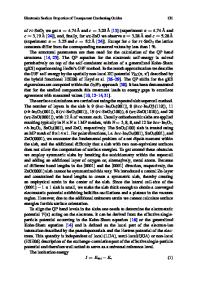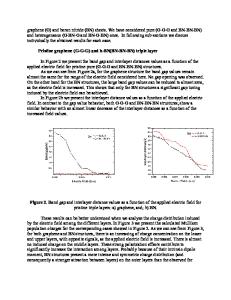Tuning structural and electronic properties of two dimensional Si and Ge based random alloys: an ab initio study
- PDF / 2,035,031 Bytes
- 15 Pages / 595.276 x 785.197 pts Page_size
- 105 Downloads / 302 Views
THE EUROPEAN PHYSICAL JOURNAL B
Regular Article
Tuning structural and electronic properties of two dimensional Si and Ge based random alloys: an ab initio study Alberto Debernardi a CNR-IMM, sede Agrate Brianza, Institute for Microelectronics and Microsystems, Via Olivetti 2, 20864 Agrate Brianza, Italy
Received 6 December 2019 / Received in final form 2 May 2020 Published online 22 June 2020 c EDP Sciences / Societ`
a Italiana di Fisica / Springer-Verlag GmbH Germany, part of Springer Nature, 2020 Abstract. By plane-wave pseudopotential techniques we simulated structural and electronic properties of novel two-dimensional (2D) materials composed of Si and Ge randomly placed at the lattice sites of a honeycomb structure: 2D-Si1−x Gex , and 2D-(H@Si)1−x (Ge@H)x , the corresponding H-passivated alloy. We investigated the formation of a random network of Si and Ge in 2D-honeycomb structure and proved the thermal stability of H-passivated SiGe alloy by computing the formation energy of these 2D-compounds. The 2D-Si1−x Gex random alloy is a semi-metal and presents at the Fermi energy a density of states resembling the one produced by the Dirac’s cone of silicene and germanene, suggesting the possibility to induce, in 2D-Si1−x Gex Dirac’s cone, a population of high velocity carriers that behaves like massless Dirac fermions. The 2D-(H@Si)1−x (Ge@H)x random alloy is a semiconductor and presents a tunable direct bandgap that doubles by decreasing the concentration from x = 1 to x = 0.25, making this 2D-alloy suitable for optoelectronic applications. The lattice parameter of both 2D-alloys increases linearly with Ge concentration, thus providing a microscopic mechanism to engineer the lattice parameter and/or the electronic properties of 2D-heterostructures based on these 2D-materials. The study of elastic properties of 2D-@Si1−x Gex and 2D-(H@Si)1−x (Ge@H)x as a function of x for possible use in flexible electronics and the investigation of magnetic properties of partially H-passivated 2D-(H@Si)1−x Gex random alloy for concentration close to x = 0.5 for spintronic applications complete the work.
1 Introduction The rising interest of solid state community toward twodimensional (2D) materials is driven by the capability of first principles computational techniques to predict structural and electronic properties of these mono-layered compounds for their potential use as building block in new-conception planar devices ranging from molecular sensor, to energy harvesting, or to ultimate-scaled electronics [1,2]. Among 2D-materials, silicene (2D-Si) and germanene (2D-Ge), the analogous of graphene but composed of Si and Ge respectively, have been studied both theoretically [3–7] and experimentally [8–11] for their compatibility with industrial processes presently based on Si and Ge technology. The integration of 2D materials constituted of Si or Ge is presently in progress: a field effect transistor based on silicene has been reported [12]. Further, the hydrogenated silicene and germanene, called silicane (2DH@Si2 @H) and ger
Data Loading...










